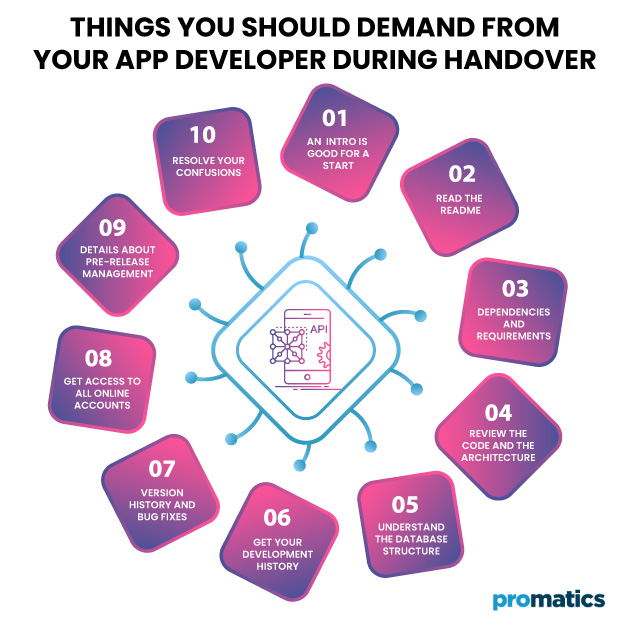The Ultimate Checklist for App Handover
When you have an app development company already taking care of whatever is going on with your app, you do not have much to worry about because the agency’s team is taking care of everything. They know what they have developed, how they have implemented the features, and how they are going to take things ahead in the future. But once the project comes into your in-house team or you want to change your developer, things can get really messy.
To begin with, you need to know about how the code is structured, its environment and where do you take these scary lines of code from here. Just like every other, this change is going to need your time and attention and you must expect problems but things can be smoothened out to a great extent by the combined involvement of both the previous and the upcoming developing team, whether in-house or outsourced.
Here is a list of things that you should look into while taking delivery of your app from your developer so that you encounter minimum problems during the change of command.
1. An Intro is good for a start
When you are taking delivery of your app, you might need to go back and forth with the previous developer to understand the details. However, a brief introduction about the overall structure and environment with regards to different development stages can be a good start.
You can ask the engineers to give a small presentation that can cover the bird’s eye aspects of the app and simultaneously receive the files. This will give a head start on how to approach the project as a whole and assist you in understanding the mechanics. Plus, you get to ask some questions on the spot so you know where, to begin with!
Now there is a great chance that you have been regularly in touch with the engineers and you already know quite a lot of what is going on. But still, an introductory meeting is always a good idea to yourself up-to-speed on your app and avoid starting from square one all over.
2. Read the Readme
If you are someone who is not a developer themselves but are reading this because you need to know, you might have come across some ‘Readme’ files on your computer that were actually a Notepad with essays written in it (yeah, the one you delete without a second thought).
These Readme files are actually the developer trying to explain the app, things that are going on within, the environment it runs, the language, libraries and infrastructure, and so on. The Readme file is crucial for any developer to understand the app and the project because these files build the foundation for understanding the magic that happens in the code.
An important part of the Readme is the setup and deployment instructions. While your app will definitely need some setup instructions. The need for deployment instructions depends on ‘at what stage, is your app’. If you have the app already launched on the Play Store or the App Store, there is not much need for those but if you have it in an intermediary phase, you are probably going to need it.
Read the Readme and you will know about the basics. You can note down your queries and ring the developer but keep a hold on the phone, there may be loads of other stuff you might want to ask.
3. Dependencies and Requirements
For all the non-developers out there, there is a lot more to the story than the iconic black and green coding screens, whose images you see roaming about here and there. The black and green on the coding screen is the source code but in order to run the source code, you have to be aware of the file formats, system requirements, the environment it is going to run in, and what packages and libraries you are going to need.
All of this information is a critical part of any app development project and you need to have thorough information about it. You would like to follow the setup and environment instructions and actually try to get it to work because who knows what problem you might run into.
4. Review the Code and the Architecture
The best way to understand the code and the architecture is to actually see for yourself. Look into what the previous developers have done, what are the modules of the app, how have they been organized.
Another approach that can be very useful to understand the architecture is to look at the user side of things. Install the app and look into the different features of the app. Once you have done this, you will have a better idea of how the structure has been put together and how the code translates into a feature for the user.
As you are analyzing the code, you are likely to come across a number of items; it can function that you do not completely understand or a class that you can not trace along with the code. There is a possibility that many items that you cannot completely trace are not relevant anymore and should be deleted from the code. As a developer, you will be reluctant to delete it yourself because you have just started with the code and may not feel confident that you completely understand all bits and pieces.
While the previous developers should have reviewed the code and deleted irrelevant items themselves, they are the authority on what was written when and why, and if it is safe to remove it. There might be some bits that were written for future improvement, they may not be complete as the app changes hands. Try to get a list of items in the code from the previous developer who thinks that are not relevant anymore or can be used but have not been completely implemented. There are one hundred and one possibilities and you should try to get the most from the original team.
5. Understand the Database structure
Databases are equally complex as the coding itself. You can have a couple of hundred columns of information in tens of different modules that are sending information and taking instructions from the app. This can be a bit of a fuss because you need to know how the database has been structured and trace actions in the source code.
Besides just like the code itself, the database can have unused components that may or may not be helpful in the future. So having a complete understanding of the database is absolutely important to save your users downtime once the app changes hands.
6. Get your Development History
It is pretty understandable if your previous developers are not exactly cooperating during the process because they are essentially helping in successfully turning away their business. However, as a professional, all developers should ensure that the successor team has everything that it needs to make the app successful in the future. Thus, I find it as our moral and professional obligation to share details about the different stages of development of the mobile app.
This includes sharing with the next team the entire journey of how they started and got through different stages of developing the app. Not to forget, the dead-ends and blockades that the engineers encountered during the process and how they solved them. This might feel like asking too much from the previous developer but as a company, you want to make sure that a smooth and successful transition of the team takes place and so, monetary encouragement can do the trick in this regard.
7. Version History and Bug fixes
When it comes to smartphone applications, bug fixes, app updates, and versions go hand in hand with each other. As a company that has built a new app, you should be aware of the fact that even in the best developed of systems, there is always room for optimizations and improvements. Not to forget, the random bugs that keep showing every once in a while and do nothing but ruin the user’s experience.
Make sure that the previous developers share all details about the version history of the app and changes they have made over the course of its lifetime. This will not only save a great deal of time for the new team but also make sure that they do not encounter unnecessary problems in rolling out regular updates and making improvements.
8. Get access to all online Accounts
This is one of the most important parts of the whole app delivery process. It is very likely that your app will be linked with multiple software as a service – SaaS accounts such as AWS or Mailchimp. Your app operates by using services from these platforms and hundreds of GBs of data are already on there even if the app has not even launched.
It is a common practice for developers to sign up on websites with separate accounts or client’s accounts whenever they link an AWS account to an app so it is generally a compulsory part of the transition process. However, make sure that once you have access to these accounts you have changed the passwords to avoid any possible security threats to your app.
9. Details about Pre-release Management
Once your developer had listed your app on any online marketplace, it is probable that they had released a Beta version for user feedback before the actual release. In case, your app is in the Beta phase, make sure that you have obtained the detailed plan that the developer had prepared for the Beta phase and the ultimate launch afterward.
This will not only aid in the smooth transition but also make sure that the app gets proper polishing during the Beta phase even despite the change in the engineering team and the users get a perfect experience once the app is delivered.
10. Resolve your confusions
Ensure that you have looked into the documentation and the source code of your app with as much detail as possible. This is important at the transition stage reason being the predecessor developer will be available to clear your confusions and misconceptions. However, once the process is over, the new app developers are all on their own.
So, irrespective of whether it is your in-house team taking over or you are engaging a new software house to maintain your app, get your confusions and queries resolved in time to avoid any discomfort.
Conclusion
Taking delivery of your app is a sensitive step in the lifecycle of your app. It is vital that the process is completed with as much detail as possible for a smooth transition. These steps will help you cover all areas of your app so once your app has completed the transition, it can continue on its journey towards success seamlessly.
Still have your concerns?
Your concerns are legit, and we know how to deal with them. Hook us up for a discussion, no strings attached, and we will show how we can add value to your operations!

